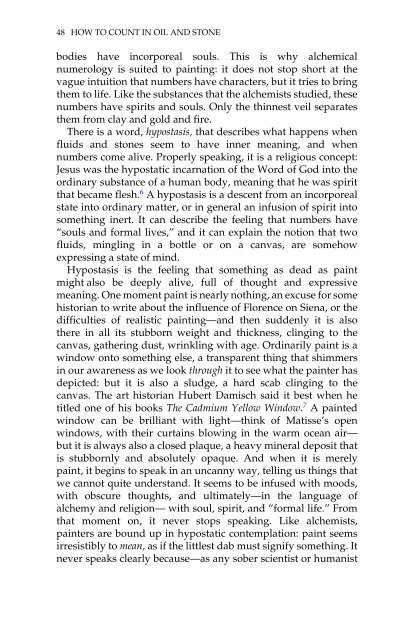What Painting Is: How to Think about Oil Painting ... - Victoria Vesna
What Painting Is: How to Think about Oil Painting ... - Victoria Vesna
What Painting Is: How to Think about Oil Painting ... - Victoria Vesna
Create successful ePaper yourself
Turn your PDF publications into a flip-book with our unique Google optimized e-Paper software.
48 HOW TO COUNT IN OIL AND STONE<br />
bodies have incorporeal souls. This is why alchemical<br />
numerology is suited <strong>to</strong> painting: it does not s<strong>to</strong>p short at the<br />
vague intuition that numbers have characters, but it tries <strong>to</strong> bring<br />
them <strong>to</strong> life. Like the substances that the alchemists studied, these<br />
numbers have spirits and souls. Only the thinnest veil separates<br />
them from clay and gold and fire.<br />
There is a word, hypostasis, that describes what happens when<br />
fluids and s<strong>to</strong>nes seem <strong>to</strong> have inner meaning, and when<br />
numbers come alive. Properly speaking, it is a religious concept:<br />
Jesus was the hypostatic incarnation of the Word of God in<strong>to</strong> the<br />
ordinary substance of a human body, meaning that he was spirit<br />
that became flesh. 6 A hypostasis is a descent from an incorporeal<br />
state in<strong>to</strong> ordinary matter, or in general an infusion of spirit in<strong>to</strong><br />
something inert. It can describe the feeling that numbers have<br />
“souls and formal lives,” and it can explain the notion that two<br />
fluids, mingling in a bottle or on a canvas, are somehow<br />
expressing a state of mind.<br />
Hypostasis is the feeling that something as dead as paint<br />
might also be deeply alive, full of thought and expressive<br />
meaning. One moment paint is nearly nothing, an excuse for some<br />
his<strong>to</strong>rian <strong>to</strong> write <strong>about</strong> the influence of Florence on Siena, or the<br />
difficulties of realistic painting—and then suddenly it is also<br />
there in all its stubborn weight and thickness, clinging <strong>to</strong> the<br />
canvas, gathering dust, wrinkling with age. Ordinarily paint is a<br />
window on<strong>to</strong> something else, a transparent thing that shimmers<br />
in our awareness as we look through it <strong>to</strong> see what the painter has<br />
depicted: but it is also a sludge, a hard scab clinging <strong>to</strong> the<br />
canvas. The art his<strong>to</strong>rian Hubert Damisch said it best when he<br />
titled one of his books The Cadmium Yellow Window. 7 A painted<br />
window can be brilliant with light—think of Matisse’s open<br />
windows, with their curtains blowing in the warm ocean air—<br />
but it is always also a closed plaque, a heavy mineral deposit that<br />
is stubbornly and absolutely opaque. And when it is merely<br />
paint, it begins <strong>to</strong> speak in an uncanny way, telling us things that<br />
we cannot quite understand. It seems <strong>to</strong> be infused with moods,<br />
with obscure thoughts, and ultimately—in the language of<br />
alchemy and religion— with soul, spirit, and “formal life.” From<br />
that moment on, it never s<strong>to</strong>ps speaking. Like alchemists,<br />
painters are bound up in hypostatic contemplation: paint seems<br />
irresistibly <strong>to</strong> mean, as if the littlest dab must signify something. It<br />
never speaks clearly because—as any sober scientist or humanist


